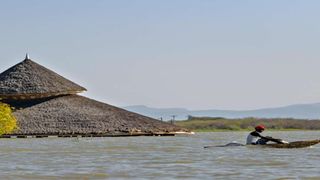
A local fisherman paddles a traditional raft made from reeds past one of the submerged buildings of the Soi Lodge on the shores of Lake Baringo on October 6, 2020.
| Tonny Karumba | AFPCounties
Premium
Kenya lost Sh4bn to damage caused by Rift Valley waters
Kenya lost Sh4 billion due to the rising waters on Rift Valley lakes and the Lake Victoria Basin, latest study shows.
A multi-agency technical team that had been formed to investigate the impact of the geographical changes said recently many tourist facilities were submerged, leading to the loss of thousands of jobs.
“From health, education, energy, water, agriculture, environment to infrastructure, the damage was felt in all sectors,” said Mr Jackson Kinyanjui, a member of the task force and founder of Climate Change Awareness Kenya, an environmental conservation organisation.
“Hotels and restaurants, lodges, camps, schools, health facilities to homesteads were submerged by the rising waters in Rift Valley lakes. It was a costly ecological disaster,” he added.
Lake Baringo swallowed and destroyed several establishments in the mainland, including multimillion-shilling tourist hotels, lodges and tented camps that were the main tourism destinations in the region.

A submerged building at the Soi Safari Lodge near Lake Baringo in Baringo County.
Most of the affected hotels, lodges and camps were on the shores of the lake while others were on several islands within the water body. The multibillion-shilling Soi Safari Lodge, for instance, was submerged.
The manager, Mr Peter Chebii, said the 200-bed facility lost revenues amounting to over Sh50 million. “The lake swallowed a large part of the facility. We suffered heavy losses. Soi was one of the most preferred tourism destinations at Lake Baringo,” he said.
Island Camp, Lake Baringo Club and Robert’s Camp were also submerged. Sheries Island, Tumbili Cliff lodge, Dr Richard Leakey’s Snake Park and the Lake Baringo Reptile Park were also damaged.
Some 75,987 households were affected, leading to a humanitarian crisis that forced authorities to provide food, shelter, health services and clean drinking water to the affected.
The task force conducted a study between October last year and May. Its aim was to establish the causes, socio-economic impacts and to recommend interventions to avoid a recurrence.
Wildlife was not spared either as the loss of grazing land drove them to higher grounds where displaced families had also sought refuge, leading to increased cases of human-wildlife conflict.
“The main reason for the rising water levels is climate change. Evidence for this is provided by the level of rainfall in the catchment areas as documented in the various rainfall gauging stations,” states the task force.
The team also noted changes in land use practices, leading to increased run-off, causing larger volumes of water to flow directly and rapidly from the land surface into the lakes.
“The increased inflow of fresh water into some of these lakes has created instability in the already fragile ecology of the lakes, negatively affecting the resilience and distribution of certain water species. In some catchment areas, severe landslides occurred regularly,” states the report.
The region consists of discrete rift basins, which are mechanically linked by zones of rift‐oblique faulting. The lakes are a creation of the formation of the Great Eastern Africa Rift Valley in the geological period.
“At that time, the current lakes covered a much wider area referred to as the Pleistocene lakes. In historical times and more recently in 1901 and 1963, the lakes showed a significant rise,” states the report.
The team cited Lake Naivasha, with the affected areas including Kihoto Settlement and Kamere Beach (plate 16) and a number of hotels (plate 17), where over 1,500 households were displaced. A substantial number of properties and several power transformers were submerged.
Six people died in Kihoto because of distress and depression after their properties were destroyed. The fishing fraternity lost business due to beaches getting submerged.
The report highlighted an increase in human-wildlife conflict, with hippos grazing closer to settlements. It was further established that Kihoto and Karagita areas had heightened security issues.
Although fish traders on Kamere public beach had increased yields, they experienced losses with catches going stale before reaching the market.
“The only available methods for preserving the fish are sun drying and deep frying. Furthermore, the rising water levels had reduced business for the prime tourist hotels, thus leading to job losses,” states the study.
According to the State Department of Agriculture, 264.8 hectares of land and 170 households in Nakuru were affected by the rising water levels by August last year.
A significant proportion of the acreage affected was around Lake Naivasha following the loss of land and properties in Kihoto. Legal issues were on rise as the owners sought to be relocated or compensated.
Given the magnitude of this challenge, experts called on the government to partner with multilateral and bilateral partners to mobilise resources through a multi-donor programme that will resolve short, medium and long-term issues.
Through the Homeowners Association leadership, residents lamented that their issues had not been addressed.
A former landlord in Kihoto, Daniel Maina, said they were yet to get any assistance from the government since they were affected by flooding.
“I used to earn Sh16,000 a month. All that was lost due to flooding after the tenants were displaced. I was also staying within the same locality and I was really affected,” he said.






